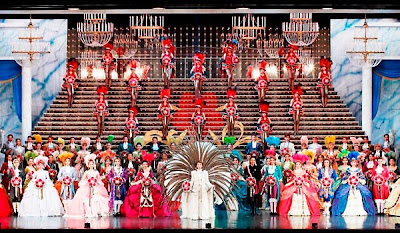Takarazuka- Japanese Theater Part V
 |
| Takarazuka, the shiniest drag kings you will ever see! Photo from here. |
Ah, Takarazuka, where do I start? It may be my favorite form of Japanese theater; I love the costumes, the music, the actors... Takarazuka may not have the history and the depth of more traditional types of Japanese theater, but in my opinion they're one of the most exciting and enjoyable to watch.
So what is Takarazuka? They're an all-female acting troupe originating from the town of Takarazuka, near Osaka. They perform Broadway-style musicals based on Western and Asian influences. The takara part of Takarazuka (宝塚) means treasure or jewel, and they certainly live up to the flashiness of their name. They're famous for their over-the-top costumes, often covered head to toe in sequins, jewels and feathers reminiscent of Vegas showgirls. The stage itself also glitters with lights and bright backdrops.
Takarazuka was founded in 1913 by Ichizo Kobayashi, the president of the Hankyu Railways. He was interested in drawing more tourism to his railway, which runs from Osaka to the town of Takarazuka. At the time Western song and dance shows were quite popular, and he decided to create something similar using an all-female troupe. This was done in reaction to Kabuki which features an all-male cast and which Kobayashi saw as being old-fashioned.
 |
| The Takarazuka Grand Theater in Hyogo Prefecture. Kinda like Camelot, minus a few turrets. Photo from here. |
The most famous Takarazuka play is The Rose of Versailles, adapted from the shoujo manga, which tells the story of a character named Oscar, a noblewoman who is raised as a boy. It's set during the French Revolution and was inspired by Osamu Tezuka's Princess Knight (which was originally inspired by Takarazuka!) Tezuka, called the "god of manga", was greatly influenced by Takarazuka, and his Princess Knight manga went on to be the inspiration for a number of other manga featuring strong female leads, such as Revolutionary Girl Utena.
Takarazuka actors are the top 40 or 50 selected each year from the thousands that apply to the Takarazuka Music School. They train for two years, the first of which is spent as a group focusing on the basics, and the second year the actors are divided into otokoyaku, male roles, and musumeyaku, female roles.
 |
| Given how pretty Japanese guys tend to be, otokoyaku are actually pretty convincing. |
Nevertheless, if you visit the Gift Shop at the Takarazuka Grand Theater, you will see any number of pin-up posters featuring masculinely dressed otokoyaku as well as feminine musumeyaku. It's been argued that the appeal of Takarazuka for many female fans is the feeling of empowerment in seeing women who are independent of traditional Japanese female gender roles. Another viewpoint is that fans enjoy the type of idealized masculinity that is portrayed by otokoyaku. I personally think that its popularity varies from fan to fan, but those are both likely reasons for its success.
 |
| Otokoyaku pin-up, featuring Ranju Tomu from Cosmos Troupe. I, uh, may have bought this one... >.> Photo from the TakaWiki. |
If you find yourself in Japan, I highly recommend a visit to the Takarazuka Grand Theater in Osaka. Not only is Osaka a fantastic city well-worth the trip, the chance to see one of Takarazuka's glittering, larger-than-life musicals is not to be passed up.
Other posts on Japanese Theater:





Great post, I was so excited to see this in my blog roll. Finally Takurazuka, now I know stuff but I still want to see a musical one.
ReplyDeleteGlad you liked it! It was kinda a lot of work- there was so much I wanted to say, so I had to edit a lot of it out. I think I'll do one more post about the show that Teal and I went to see last August.
ReplyDeleteYou should! Takarazuka is the best. I don't miss the job that much but I really miss my life in Japan. Takarazuka is one of the things I miss the most.
ReplyDelete